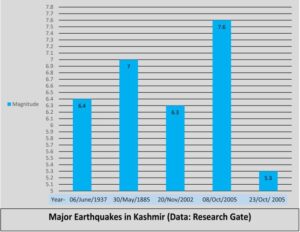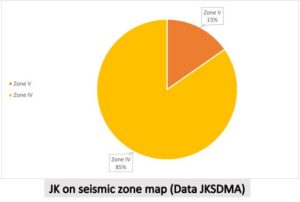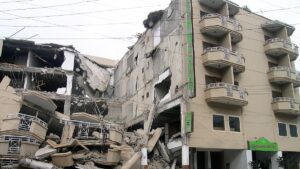Megaquake risk in Kashmir underscores need for strong buildings
By Bhat Yasir, Simran Mir, Kaiser Ali and Tabish Shakil
A potential earthquake threat is looming over Kashmir and surrounding regions as the Indian subcontinent continues to push northward and stresses continue to build on massive faults along the Himalaya arc, thus making the region more vulnerable. The experts are continuously warning that earthquakes above 8 magnitudes can strike the Himalayan region at any time.
Kashmir valley has been rocked by many moderate and large earthquakes in history. This Himalayan region falls in Zone IV and Zone V on the seismic zonation map, making it a seismically active area. No wonder, tremors are frequently felt in the region.
According to Dr. Khursheed Ahmed, HoD Geology, at Sri Pratap College Srinagar: “The stress accumulated due to pressure built by Indian plate is the basic reason that we see often earthquakes struck this region.” Surely, you can expect earthquake anywhere in the Himalayan region.”
“There is a theory called seismic gap theory, that means over a period of at least 100 years enough strains and stress is accumulated within the rocks that result in the bigger earthquake. If we look back, from the last hundred years we have not seen any big earthquake in this region particularly in Kashmir window. So that is the reason most of the geologists forecast a big earthquake may struck this region which may have magnitude between 7 and 8 on Richter scale. So it will be destructive earthquake.”
These claims are backed by a noted seismologist, Roger Bilham, who has conducted a study on the subject.
“History as well as geology tell us that the Himalayan arc will experience much bigger earthquakes than the 2005 Event–bigger than the damaging moderate earthquakes that have struck the Kashmir valley in recent centuries. Given the massive scale of faults in this part of the world, and the enormous forces, earthquakes in the range of magnitude 8.5, maybe even greater will inevitably strike,” reads Bilham’s research, titled ‘Kashmir Valley Megaearthquakes’ published in ‘American Scientist’ journal.


In recent years geologists have found the scars left behind by three monster quakes along the arc between Bhutan and Pakistan, around 1125, 1400, 1505, as per Bilham’s research. The first two dates are estimates precise to be best +50 years, it reads. Adding, the 1505 event is documented in the historical record, the shaking having destroyed Buddhist monasteries in Tibet along a 600-kilometer segment of the central Himalaya.
Recent field investigations reveal that in each of these megaquakes the frontal hills of the Himalaya advanced in a few seconds more than 20 meters over the plains of India, Bilham said in his research.
“Recent calculations moreover suggest that megaquakes, with magnitudes well above 8.0, are not just possible along the Himalayan arc; they are necessary to relieve the stresses generated by the continuing northward motion of India into Eurasia.
The research says that the 2005 Earthquake took place frequently along the Himalayan arc to relieve accumulated stresses generated by the collision of the Indian and Eurasian tectonic plates.
A temblor of magnitude 8 or greater probably has not hit the Kashmir region since the mid-1500s, making an imminent megaquake not just likely but necessary to relieve these stresses, research team said after examining geological and historical evidences. ”The devastation that would accompany a magnitude 8+ earthquake would be many times greater that of the M7.6 2005 event that was centred near Muzaffarabad.”
The researchers said that no part of the Himalaya can be spared as the Indian plate eases northward under the mountains–earthquakes are inevitable along the entire range. “This is the westernmost expression of the Himalaya, and the region that has not slipped in a large earthquake since 1555 is roughly 400 kilometers by 80 kilometers-big enough to host an M8 earthquake.”
The GPS data tell us that convergence in the region is now more than 15 millimeters per year If this convergence has been continuous since 1555, we have more than enough potential slip (6.8 meters) ready right now to drive another earthquake of similar size, researchers said.
Collision of plates
Ahmed explains the vulnerability of Kashmir to earthquakes. “Over two hundred million years before, all the continents were connected to each other, known as Pangea (Supercontinent). Then over 100 million years ago they break apart like North America, South America, Europe and Africa, and went in different directions.”
Gondwana, the Indian land mass was among it. This moved towards north, and over 30 million years ago it collided with Eurasian plate. Due to this collision the sea that was in the middle took shape of a big mountain range which is today known as Himalayas-one of the youngest and loftiest mountains, so this is the result of collision, Ahmed said.
The area from Nanga Parbat to Namchabarma is the result of that collision between Indian plate and Eurasian plate.
“So you can imagine when a collision of plates occurs how much physiographic features are made, and the Himalayas are one of the physiographic feature. Himalaya, a region of 2400km long 400km wide, is a result of that collision,” Ahmed added.
Now there are the faults, over thrusts, folded parts in this region which is the result of catastrophe or a collision and when we scan this whole area, we see the Himalayas (Extra-Peninsula region) in the sub-continent are seismically very active, he said.
Frequent tremors in Chenab region
One reason behind frequent tremors in Chenab region of Kashmir valley can be stress accumulated due to the push from the Indian plate and the other reason could be impounding of the water, “like we make big reservoirs,” Ahmed said.
“The hydrostatic pressure that is developed at one place is also developing stress in rocks and that can also be released in the form of small tremors, so they are actually anthropogenic. Even the excessive rainfall that percolates through the faults is one of the reasons. There are many reasons for these tremors, but it could be prelude to the bigger earthquake as well so we have to be combat ready.”
“Actually we should be able to minimize the impact of earthquakes through interventions, sustainable structures that is the only way to get away from these kind of earthquakes. We cannot stop them but we can actually minimize their impact that is the point,” Ahmed added.
‘Strong VS cosmetic’
The impact of earthquake can be minimized by building resilient structures, known as sustainable structures in urban geology. “We have to scan our surface (earth surface, crust) so that we can see all the parameters like lithology, structure, and gradient. When we have knowledge about our sub-surface formation then we can accordingly make any structure,” suggests Ahmed.
“In Kashmir, we invest a lot of money on cosmetics of houses and buildings although that is not important, the important is whether our structure is earthquake resilient or not and is the design of RCC structure earthquake proof? We should invest on it,” he said.

Role of GOVT
The work of government is to make people aware about in which zone we live and what kind of structures we should construct, said Ahmed.
He said that there should be laws and rules for government constructions as well and the construction should not be passed before completing all the parameters that qualify to an earthquake resistant building .
“If we succeed in building earthquake resistant structures we can definitely minimize the impact of earthquakes,” he added.
In 1930, China was struck by a big earthquake which killed over 1.22 lac people but Chinese learnt a lesson. They implemented earthquake resistant designs in the country. After 1930, many earthquakes hit China but human lives were saved considerably, the graph of killings was very down. “The reason is timely intervention, change in the design and earthquake resistant structures,” Ahmed claimed. “Actually, government has to play a very important role in this.”
“When you construct a house, it is one time investment, make it strong like you beautify it outside, this will secure your lives as well as property.”


Recent Comments